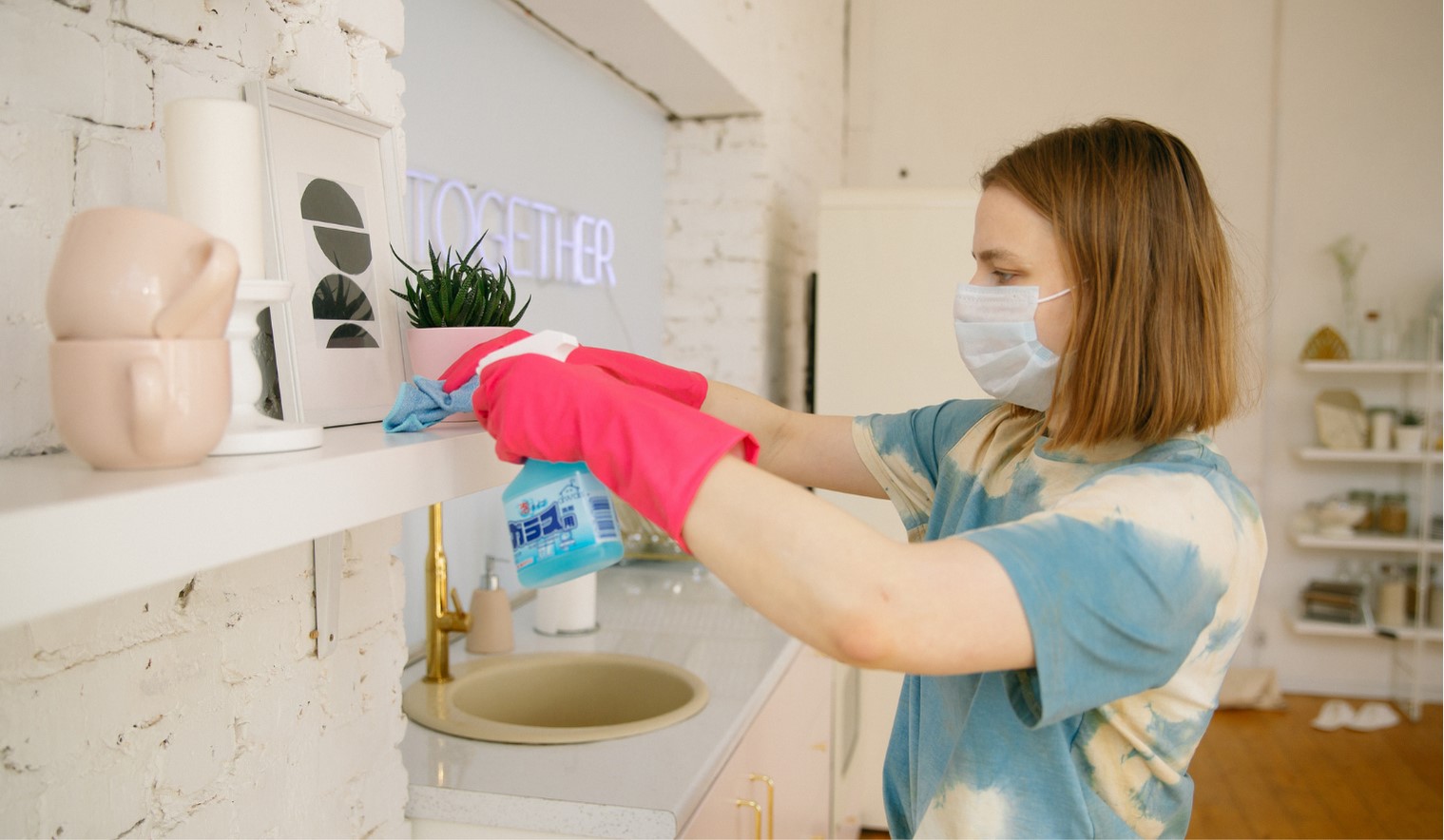Moms are always busy, and stay at home moms are no exception. Between running after kids and pets, and keeping a clean house, being a stay-at-home parent can easily become overwhelming. Having a cleaning schedule can help you stay on top of your mom-game, so to speak.
A simple cleaning schedule is an effective cleaning schedule. Regardless of how you structure your cleaning schedule, it should reflect your family’s lifestyle, and your priorities and preferences when it comes to household cleanliness.
Why Create a Stay at Home Mom Cleaning Schedule?

Mess and clutter can spread quickly, even in the cleanest of households. For many people, a cleaning schedule is the easiest way to stay on top of mess. An effective cleaning schedule can also help you visualize all your cleaning tasks along with their designated days, weeks, or months, preventing them from pilling up and becoming overwhelming.
Stay at Home Mom Cleaning Schedule Ideas
A cleaning schedule should be specific enough to provide your cleaning routine with structure, but not so much as to cause you to stress over getting chores done. A stay at home mom cleaning schedule can be arranged on a frequency basis, a room by room basis, by time blocks, or a combination of the 3.
By Frequency
A by frequency cleaning schedule is probably one of the most commonly used. Because it is also a bit more specific than the other schedule types listed here, it may take a bit more time to set up and get used to. Once you get used to it however, a by frequency schedule is one of the easiest to stick to.
Sample By Frequency Schedule
Daily
- Do Dishes
- Make Beds
- Wipe Down Bathroom and Kitchen Counters
- Empty Garbage Bins
- Clean Up Spills, Dirt, and Other Mess as Needed
Weekly
- Monday: Sweep/Vacuum and Mop Floors
- Tuesday: Disinfect Garbage Bins
- Wednesday: Change Sheets and Dust Furniture
- Thursday: Do Laundry (Clothes, Sheets, and Towels)
- Friday: Deep Clean Bathrooms
- Saturday: Clean and Flush Sinks and Garbage Disposals
Monthly
- 1st Week: Rotate Mattress
- 2nd Week: Clean Washing Machine, Dryer, and Dishwasher
- 3rd Week: Clean Baseboards and Air Conditioner Filters
- 4th Week: Dust Ceiling Fans
Quarterly
- 1st Month: Launder Pillows, Duvets, and Curtains
- 2nd Month: Clean Screen Doors and Windows
- 3rd Month: Deep Clean Refrigerator
Room by Room

A room by room schedule allows you to focus on cleaning just one or two rooms each day.
Note that with this type of schedule, there are still certain chores that you will have to do on a daily basis, such as doing dishes, emptying garbage bins, and making beds.
Sample Room by Room Schedule
Monday: Bedrooms and Hallways
Tuesday: Foyer and Living Room
Wednesday: Kitchen and Dining Room
Thursday: Bathrooms
Friday: Laundry Room
Time Block
Time Blocks are a great option for busy days when you don’t have much time for cleaning or when you want a more laid back cleaning schedule. You can also use a time block schedule as a way to remind yourself to take breaks while you work.
Set 30 to 60 minute blocks, during which time you’ll focus on your cleaning tasks. Start at the top of your chore list and go through as many tasks as you can until the timer runs out. The next time you clean, run the timer again and simply pick up where you left off.
Another option for a time block cleaning schedule is to designate cleaning tasks as “morning chores” and “afternoon chores”. Start by picking a few chores to do each day and classify them as morning chores or afternoon chores. The rest is pretty much self-explanatory – work on morning chores in the morning, and afternoon chores in the afternoon.
Combination
You can also combine different schedule styles to create a more specific schedule that serves you best. Below are 3 different combinations of a stay at home mom cleaning schedule styles that you may want to make use of or gather a few ideas from.
-
By Frequency x Room by Room
Create separate by frequency cleaning schedule for every room in your house. This more specific type of schedule allows you to do a bit of cleaning in every room of your house each day, which can help keep clutter to a minimum, especially in heavy traffic areas of your house.
-
Time Block x Room by Room
Create a list of cleaning chores to complete in each room. Set an amount of time to spend cleaning in every room. Run the timer and work your way through the list for that room. When the time runs out, move on to the next room. Some people find that this type of schedule tends to be a bit more manageable and less overwhelming by limiting the total time you spend cleaning each room.
-
By Frequency x Time Blocks
If you have regular errands to run or places to be at specific times of the day, such as school drop-offs and pick-ups or PTA meetings, a combination of by frequency and time block schedules may help you keep track of time and be where you need to be, when you need to be there.
Simply create a by frequency schedule and run a timer as you go through your lists of chores. The amount of time on your timer should correspond to your appointments and timed errands.
Creating an Effective Stay at Home Mom Cleaning Schedule

- Prepare. If you’re going to be creating a stay at home mom cleaning schedule, you’ll need a few things – some paper and writing utensils (or a note taking app on your phone) to take note of just what chores need to be done. You may also want to do this when your kids are out of the house or are asleep for the night, just to avoid getting distracted or interrupted.
- Take a walk around your house. Visit each room in your house and take note of the cleaning tasks which need to be done. For example, you might note down doing dishes, wiping down countertops, and cleaning the oven and microwave in kitchen. For the bedrooms, you might note down changing sheets and rotating mattresses.
Identifying the high and low traffic areas of your home may also help later on, especially when it comes to certain cleaning chores which are spread out over your house, such as vacuuming/mopping floors and dusting furniture. Focus on doing these chores more often in high traffic areas, as these spaces are more likely to accumulate mess and dirt.
- Decide How Often Each Task Should Be Done. Once you’ve identified what kind of cleaning tasks need to be done, figure out how frequently each task needs to be done. This part is truly up to you, your cleanliness standards, and your tolerance for clutter. Dividing tasks into daily, weekly, bi-weekly, monthly, and even quarterly chores is a good starting point.
Think about how much time you have available and your family’s lifestyle. Everyone has different priorities and opinions as to how often everything need to be cleaned. If you are frequently busy on weekdays, you may want to leave more time consuming chores such as window washing to the weekends. If your kids go to school or daycare on weekdays, you may not need to clean the playroom as much as someone with young kids or a baby does.
Most things in your home such as floors, laundry, and large pieces of furniture can do with weekly and bi-weekly cleaning, while heavily trafficked rooms and surfaces that can quickly attract and spread bacteria such as dirty dishes and garbage bins need daily keeping up with.
- Feel Free to Make Changes. Once you start following your stay at home mom cleaning schedule, feel free to tweak the schedule to make it work better for you. After all, the schedule needs to work for you, not the other way around.
- Get Everyone Involved. Get everyone in your household involved in chores. Giving kids developmentally appropriate chores that they can independently accomplish is a great way to instill the habit of cleanliness and hygiene in them. As a bonus, it also decreases he number of chores you need to do.
- Stick to It. It takes practice and consistency to turn your newly formulated cleaning schedule into a smooth running, well-oiled machine. Once you’ve figured out a cleaning schedule that works for you, stick to it. It will be hard at first, but just like with anything else, it will get easier with time.

